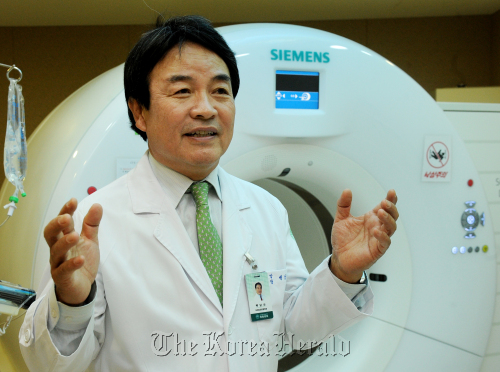“I also thought a more creative management would be possible here. There was no reason to think twice,” he said.
Affiliated with the prestigious 124-year-old school ― one of the oldest women’s universities in the world ― the hospital was established in 2009 to offer services customized for female cancer patients.
After a soft-landing in the first two years, the cancer center is now preparing another leap forward together with Paik, a celebrity doctor who was also registered among the world’s top 100 gastric and breast cancer surgeons according to the International Biographical Center of Cambridge, U.K., in 2006.
A patient-friendly atmosphere is the very basic minimum when it comes to treating female cancer patients suffering from physical and psychological loss, he said.
For the convenience of patients, the cancer center offers a rare one-stop service, under which a patient can receive all treatments and tests within a day of arriving at the hospital.
When a patient is diagnosed with cancer, all treatments are to be completed within a week, an attractive point especially for long-distance patients.
A cancer patient, regardless of whether she was diagnosed at the hospital or not, is given priority to be tested on the day she visits the center.
Taking the hospital global is the other ambitious mission assigned to Paik, who has boosted the hospital’s international recognition after successful surgeries on foreign patients from countries including China, Mongolia, Russia, the U.S. and the Middle East.
The number of breast cancer patients in Asia is still smaller than in the West.
However, the growth rate is much higher in Asia. While prevalence of breast cancer increases by 1.1 percent annually in the U.S., the Korean rate is growing by 6.7 percent.
According to Paik, Asian women’s typically smaller breasts have a more complicated tissue structure that is more vulnerable to cancer. Along with Westernized eating habits, late marriage and pregnancy are accelerating the disease’s occurrence in Asian women, he explained.
In particular, Korean breast cancer patients are relatively younger as many of them are in their 30s or 40s. The tendency also led to the nation’s advancement in the field of breast-conserving or reconstruction surgery, he added.
“The demand for breast cancer surgery will soar in the coming years. Equipped with excellent skills and experiences, Korean doctors will receive attention from foreign patients, especially from Asia,” Paik said.
The nation’s quality medical services are a bargain compared to other advanced countries ― the price is still one fifth or one tenth compared to many advanced countries.
“In case of PET-CT, which detects cancer in every part of a body, you have to pay about $7,000 to have the test in the U.S., while in Korea it takes only 1.2 million won ($1,000). If you are a Korean citizen, you pay just 250,000 won,” he said.
“The more important thing in treating foreign patients is long-term screening. In order to do that, I have maintained good relationships with international hospitals, universities and their doctors around the world,” he said.
As part of the efforts, he has also pushed ahead with the adoption of new equipment called IORT or Intra-Operative-Radiation Therapy, which is under government clinical trial to be introduced for the first time in Korea within the year.
“A cancer patient is to take radiation treatment for two months after surgery. But the equipment makes it once during surgery or reduces it to at least two weeks so that the patient’s economic and psychological burdens are dramatically relieved,” he said.
The equipment is still new even in the U.S. and Germany.
Paik still remembers a young single patient who had to have her breast removed.
“She was in despair. But I encouraged her that she could get married and have a baby. A few years later, she visited me again with twins,” he said with a smile.
Paik is also known as a doctor who sings jazz songs. During his inaugural ceremony held on May 16, he sang “Mona Lisa” by Nat King Cole in front of some 300 patients and their family members.
“I think an excellent doctor makes patients feel easy and comfortable. If the hospital keeps in mind this very basic thing, I believe it will become Asia’s best women’s hospital in the near future,” he said.
By Lee Ji-yoon (
jylee@heraldcorp.com)








![[Today’s K-pop] Blackpink’s Jennie, Lisa invited to Coachella as solo acts](http://res.heraldm.com/phpwas/restmb_idxmake.php?idx=644&simg=/content/image/2024/11/21/20241121050099_0.jpg)